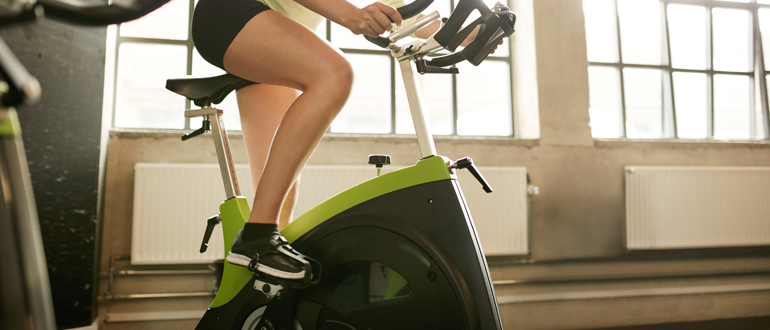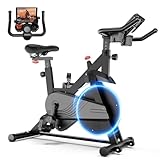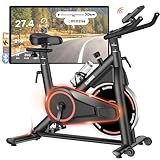
A Low-Impact Cardio Favourite
Exercise bikes, also known as stationary bikes, are a staple in gyms and home workouts alike. Designed to replicate the pedalling motion of a traditional bicycle, they allow you to enjoy the benefits of cycling without needing to go outdoors. With pedals, handlebars, and a saddle, they look much like regular bikes – just without the wheels or the need to balance.
Whether you're aiming to boost cardiovascular fitness, burn calories, strengthen your lower body, or recover from injury, an exercise bike can be a valuable and versatile addition to your workout routine.
How Do Exercise Bikes Work?
Unlike road bikes, exercise bikes remain in one place, but that doesn’t mean the workout is static. Most models let you adjust the resistance level, so you can control how easy or hard it feels to pedal. This flexibility means you can tailor each session to your own fitness level, training goal, or energy level for the day.
You can go for a gentle ride to warm up or cool down, or turn up the resistance for a challenging hill climb simulation to really get your heart rate up. Some bikes even come with built-in training programmes, heart rate monitors, and app connectivity to help you stay motivated and track your progress.
Benefits of Using an Exercise Bike
- Low-impact on joints – Great for those with knee, hip or back concerns
- Improves cardiovascular health – Supports heart and lung function
- Burns calories – Ideal for weight loss and endurance training
- Strengthens lower body muscles – Especially the quads, hamstrings, calves, and glutes
- Customisable intensity – Suitable for beginners through to experienced athletes
- Weather-proof – No need to worry about traffic or rain
Ideal for Home Workouts
Exercise bikes are also a top choice for home workouts. They’re compact, quiet, and easy to use, making them suitable for people living in flats or those who want to get active without taking up too much space. Many models start at around £150–£200, with higher-end versions offering extra features like touchscreen consoles, resistance-based training programmes, and even virtual rides through scenic landscapes.
Physiotherapy and Recovery
Exercise bikes are frequently recommended as part of rehabilitation and physiotherapy programmes, especially for individuals recovering from lower-body injuries. Because cycling on a stationary bike is non-weight-bearing and low-impact, it can help improve circulation, range of motion, and muscle strength without placing excessive stress on joints or healing tissues.
They are particularly helpful for:
- Knee and hip rehab
- Post-operative recovery
- Building strength after long periods of inactivity
However, it’s always important to seek advice from a GP, physiotherapist or healthcare professional before starting or resuming exercise after an injury. They can help you determine whether an exercise bike is suitable and how to use it safely and effectively in your recovery plan.
Final Thoughts
Whether you're new to fitness, returning after injury, or looking to improve your cardio endurance, an exercise bike offers a safe, effective, and user-friendly way to stay active. With its ability to adapt to different fitness levels and goals, it’s no surprise that the exercise bike remains one of the most popular and practical pieces of cardio equipment.
Best Selling Exercise Bikes by Brand
| # | Preview | Product | Price | |
|---|---|---|---|---|
| 1 |

|
NordicTrack T Series 9 Bike |
£599.00 |
Buy on Amazon |
| 2 |

|
NordicTrack GX LE Upright Bike, Black |
£599.00 |
Buy on Amazon |
| 3 |

|
NordicTrack X24 Bike |
£1,999.00 |
Buy on Amazon |
| 4 |

|
NordicTrack GX LE Recumbent Bike, Black |
£829.00 |
Buy on Amazon |
| 5 |

|
NordicTrack GX10 Recumbent Bike, Black |
£1,499.00 |
Buy on Amazon |
How to Choose the Best Exercise Bike for Home Use
With so many types of exercise bikes on the market, it can be a bit overwhelming to know where to start. Whether you're aiming to improve your fitness, lose weight, or recover from injury, choosing the right bike can make a huge difference to your motivation and results.
This guide will walk you through the key factors to consider when buying an exercise bike for your home.
Types of Exercise Bikes
There are three main styles of exercise bikes, each offering different features and benefits:
1. Upright Bikes
- Most similar to a regular bicycle
- Encourages a natural riding position
- Great for general fitness and cardio
- Takes up less space than other styles
Best for: Most users looking for a well-rounded cardio workout
2. Recumbent Bikes
- Has a reclined seat with back support
- Pedals are positioned in front of the body
- Easier on the lower back and joints
Best for: Older adults, people with back/knee issues, and injury recovery
3. Spin Bikes
- Built for high-intensity workouts
- Heavy flywheel for smoother pedalling
- Requires a more aggressive riding position
Best for: Serious cyclists, HIIT fans, or those who enjoy spin classes
Resistance Type
The type of resistance affects how smooth and quiet the ride feels, as well as the overall durability of the bike.
1. Magnetic Resistance
- Quiet, smooth and low maintenance
- Easy to adjust resistance levels
Ideal for: Home use, especially in shared spaces
2. Friction Resistance
- Uses brake pads for resistance
- Often found on spin bikes
Note: Can be noisy and may need maintenance over time
Size and Space
Before you buy, consider:
- How much space you have (measure the area if needed)
- Portability – Look for transport wheels if you need to move it around
- Foldability – Some upright models are foldable for small homes or flats
Console Features & Tracking
Many modern bikes come with digital consoles that track:
- Time
- Speed
- Distance
- Calories burned
- Heart rate (via pulse sensors or chest straps)
Higher-end models may offer:
- Built-in workout programmes
- App connectivity (e.g., Zwift, iFit, or Kinomap)
- Bluetooth and USB ports
- Touchscreens with virtual rides or fitness classes
Tip: Even basic metrics like time and resistance level can be useful for staying motivated.
Comfort & Adjustability
Your comfort is crucial – if the bike is uncomfortable, you’re less likely to use it.
Look for:
- Adjustable seat height and horizontal adjustment
- Adjustable handlebars
- A well-padded seat (you can also buy a gel seat cover)
- Suitable weight limit and frame size for your body
Tip: If multiple people will use the bike, adjustability is even more important.
Budget
Prices can range from £150 to over £1,000, depending on features and brand. Here’s a rough guide:
Price Range & What to Expect
£150 – £300 Basic upright bikes, manual resistance, limited features
£300 – £600 Better build quality, magnetic resistance, basic display
£600 – £1,000+ Commercial-grade features, smart consoles, app integration
Tip: Think about which features are essential for you. You don’t always need to spend a fortune to get a great workout.
Warranty & Aftercare
Check for:
- Warranty length (especially on the frame and electronics)
- Customer support
- Availability of replacement parts
Tip: Read reviews to get a sense of the brand’s reliability and customer service.
Assembly
Most exercise bikes require some assembly. If you’re not confident with tools, consider:
- Buying from a retailer that offers assembly
- Checking if assembly instructions are available online or via video
Final Tips
- Try before you buy if possible – test one in-store or read video reviews
- Read customer reviews to find out how it performs in real homes
- Be realistic about your goals – choose a bike that matches your training needs
In Summary
Choosing the right exercise bike comes down to:
- Your fitness goals
- Space available
- Budget
- Preference for comfort and features
With the right choice, a good exercise bike can help you stay active, improve your cardiovascular health, and maintain a consistent routine – all from the comfort of your home.











































